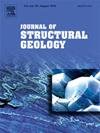Failure mode transition in brittle boudinage: Effects of cohesion, confining pressure, and layer thickness
IF 2.9
2区 地球科学
Q2 GEOSCIENCES, MULTIDISCIPLINARY
引用次数: 0
Abstract
Boudins are ubiquitous periodic structures that form during layer-parallel extension of competent material embedded in less competent material. They can have a wide range of geometries, depending on paleo-rheological conditions. This makes them a powerful tool in interpreting the time–temperature and deformation history of a rock package. Consequently, multiple field and modeling studies have described their geometries as well as explored the boundary conditions for their formation. Inspired by previous findings in modeling and field studies, we test the hypothesis that boudin end member geometries, such as pinch-and-swell, domino, torn, and shear band boudins, can be realized with purely brittle–elastic behavior of the boudinaged layer embedded in a viscous matrix. For this purpose, we designed a parametric Discrete Element Modeling study in which different failure modes in the brittle material are achieved by varying the layer thickness, material cohesion and the layer parallel confining stress. We show that the different boudin geometry is a first order result of the failure mode, fracture mechanics in the brittle layer and the associated post failure behavior. Our models confirm previous findings that block rotation of boudins may be associated with coaxial deformation. Our models indicate a failure mode transition exits between torn and drawn boudins. These results may help us better understand the evolution of boudins and thus help interpret natural examples such as the boudin trains in Naxos, Greece.

脆性边界的破坏模式转变:黏聚力、围压和层厚的影响
粘结层是一种普遍存在的周期性结构,它是在活性物质嵌入活性物质的层平行扩展过程中形成的。根据古流变条件的不同,它们可以有各种各样的几何形状。这使它们成为解释岩石包裹的时间-温度和变形历史的有力工具。因此,许多实地和建模研究已经描述了它们的几何形状,并探索了它们形成的边界条件。受先前建模和现场研究结果的启发,我们验证了一个假设,即绑定端构件几何形状,如夹胀、多米诺、撕裂和剪切带绑定,可以通过嵌入粘性矩阵的绑定层的纯脆性-弹性行为来实现。为此,我们设计了一个参数化离散元模型研究,通过改变层厚、材料黏聚力和层平行围应力来实现脆性材料的不同破坏模式。研究表明,不同的边界几何是破坏模式、脆性层断裂力学和相关的破坏后行为的一阶结果。我们的模型证实了先前的发现,即块体旋转可能与同轴变形有关。我们的模型表明在撕裂边界和拉伸边界之间存在失效模式转换。这些结果可能有助于我们更好地理解生物的进化,从而有助于解释自然例子,如希腊纳克索斯的生物列车。
本文章由计算机程序翻译,如有差异,请以英文原文为准。
求助全文
约1分钟内获得全文
求助全文
来源期刊

Journal of Structural Geology
地学-地球科学综合
CiteScore
6.00
自引率
19.40%
发文量
192
审稿时长
15.7 weeks
期刊介绍:
The Journal of Structural Geology publishes process-oriented investigations about structural geology using appropriate combinations of analog and digital field data, seismic reflection data, satellite-derived data, geometric analysis, kinematic analysis, laboratory experiments, computer visualizations, and analogue or numerical modelling on all scales. Contributions are encouraged to draw perspectives from rheology, rock mechanics, geophysics,metamorphism, sedimentology, petroleum geology, economic geology, geodynamics, planetary geology, tectonics and neotectonics to provide a more powerful understanding of deformation processes and systems. Given the visual nature of the discipline, supplementary materials that portray the data and analysis in 3-D or quasi 3-D manners, including the use of videos, and/or graphical abstracts can significantly strengthen the impact of contributions.
 求助内容:
求助内容: 应助结果提醒方式:
应助结果提醒方式:


